Gaming Performance
The big question here is whether or not the CPU is going to be the bottleneck with the selected graphics card. As you'll see, the processor can be a limiting factor in the stock systems, depending on the game, but once we start overclocking everything begins to even out.

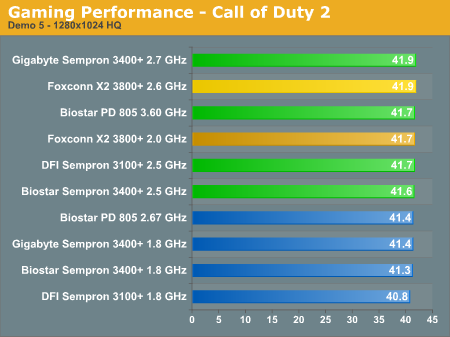
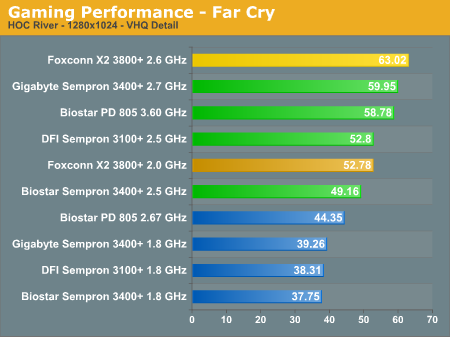
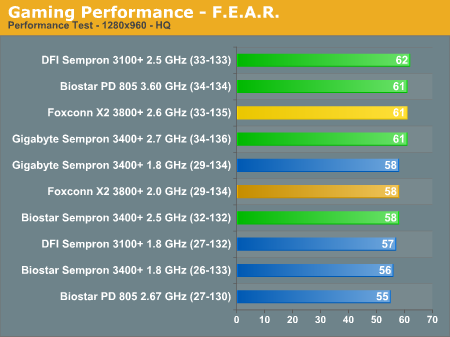
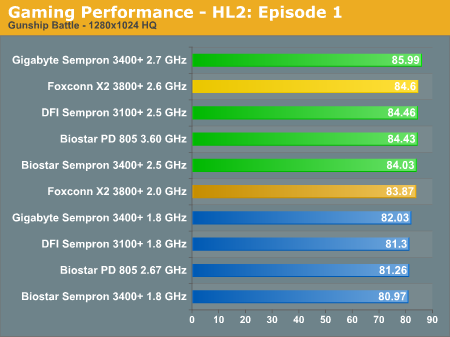

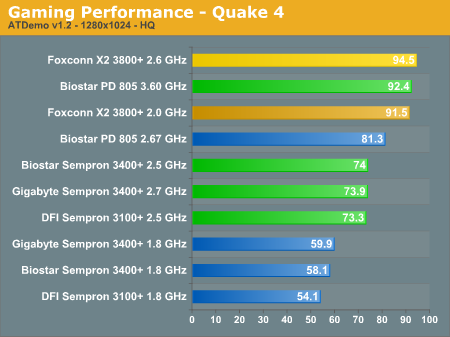
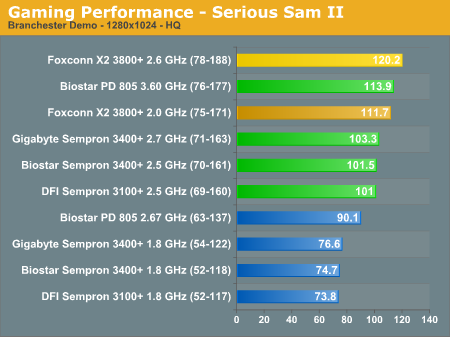
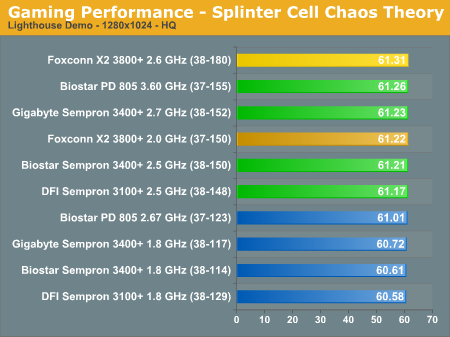
We could have continued running additional benchmarks, but basically it's pretty clear that the 7600 GT has reached its limits in many of the games with the overclocked processors. The good news is that all of the games were very playable at 1280x1024 resolution, so unless you demand things like antialiasing and higher resolutions, this graphics card should be sufficient. In fact, quite a few games can even run well with antialiasing enabled and/or higher resolutions.
Far Cry, Serious Sam 2, Quake 4, and Battlefield 2 all benefit from having a faster processor, but you can see that the graphs begin to flatten out at the top. (We're not quite sure what's going on with the X2 Battlefield 2 performance, but repeated testing garnered the same results. Apparently, that particular game really does well on the X2 chips.) Upcoming titles will likely require more graphics processing power, but in the future you will also be able to upgrade to a faster GPU for less money than that level of performance currently costs. The two SMP aware games that we tested showed differing results. Call of Duty 2 simply taxes the graphics card too much to really benefit from a faster processor. Quake 4 on the other hand shows some significant performance improvements, though once we enabled antialiasing most of those disappeared.
Taking a look at the performance offered by the various platforms, all of the overclocked systems perform very well. Without overclocking, the Sempron AM2 system is surprisingly at the bottom of the list when we used the Biostar motherboard, which is why we also tested with the Gigabyte board. The difference isn't huge, but the Gigabyte board is almost always 3% to 10% faster at the same clock speed and memory settings. This almost certainly points to a less optimized BIOS in the Biostar board, which isn't too surprising as most optimization efforts are focused on the enthusiast motherboards rather than the value offerings.
While historically AMD's K8 architecture has outperformed Intel's NetBurst architecture in games, the Pentium D 805 generally places ahead of the two Sempron chips, even with the slower front side bus. It would appear that the reduced L2 cache on the Sempron chips versus the larger L2 cache on the Pentium D results in the 805 being better overall for gaming. NetBurst has always done very poorly with reduced amounts of L2 cache (just take a look at the performance of the Celeron chips), but with the budget priced Smithfield core Intel jumps back into the lead for this price point.
Looking at the overclocked results again, most of the scores are in line with what we expected. Sempron AM2 is able to surpass Sempron 754 when we're not GPU limited, due at least in part to the higher clock speed we attained. It would also appear that higher clock speeds place more of a burden on system memory, so the dual channel memory comes out ahead. We would expect Sempron AM2 to be better overall, as it runs on a newer platform and we used a more expensive processor. Really, though, if you already have a decent 754 system, upgrading certainly isn't required (yet). If Athlon X2 on socket 939 wasn't enough to get you to upgrade, Athlon X2 on AM2 doesn't change things much.
The big question here is whether or not the CPU is going to be the bottleneck with the selected graphics card. As you'll see, the processor can be a limiting factor in the stock systems, depending on the game, but once we start overclocking everything begins to even out.









We could have continued running additional benchmarks, but basically it's pretty clear that the 7600 GT has reached its limits in many of the games with the overclocked processors. The good news is that all of the games were very playable at 1280x1024 resolution, so unless you demand things like antialiasing and higher resolutions, this graphics card should be sufficient. In fact, quite a few games can even run well with antialiasing enabled and/or higher resolutions.
Far Cry, Serious Sam 2, Quake 4, and Battlefield 2 all benefit from having a faster processor, but you can see that the graphs begin to flatten out at the top. (We're not quite sure what's going on with the X2 Battlefield 2 performance, but repeated testing garnered the same results. Apparently, that particular game really does well on the X2 chips.) Upcoming titles will likely require more graphics processing power, but in the future you will also be able to upgrade to a faster GPU for less money than that level of performance currently costs. The two SMP aware games that we tested showed differing results. Call of Duty 2 simply taxes the graphics card too much to really benefit from a faster processor. Quake 4 on the other hand shows some significant performance improvements, though once we enabled antialiasing most of those disappeared.
Taking a look at the performance offered by the various platforms, all of the overclocked systems perform very well. Without overclocking, the Sempron AM2 system is surprisingly at the bottom of the list when we used the Biostar motherboard, which is why we also tested with the Gigabyte board. The difference isn't huge, but the Gigabyte board is almost always 3% to 10% faster at the same clock speed and memory settings. This almost certainly points to a less optimized BIOS in the Biostar board, which isn't too surprising as most optimization efforts are focused on the enthusiast motherboards rather than the value offerings.
While historically AMD's K8 architecture has outperformed Intel's NetBurst architecture in games, the Pentium D 805 generally places ahead of the two Sempron chips, even with the slower front side bus. It would appear that the reduced L2 cache on the Sempron chips versus the larger L2 cache on the Pentium D results in the 805 being better overall for gaming. NetBurst has always done very poorly with reduced amounts of L2 cache (just take a look at the performance of the Celeron chips), but with the budget priced Smithfield core Intel jumps back into the lead for this price point.
Looking at the overclocked results again, most of the scores are in line with what we expected. Sempron AM2 is able to surpass Sempron 754 when we're not GPU limited, due at least in part to the higher clock speed we attained. It would also appear that higher clock speeds place more of a burden on system memory, so the dual channel memory comes out ahead. We would expect Sempron AM2 to be better overall, as it runs on a newer platform and we used a more expensive processor. Really, though, if you already have a decent 754 system, upgrading certainly isn't required (yet). If Athlon X2 on socket 939 wasn't enough to get you to upgrade, Athlon X2 on AM2 doesn't change things much.










56 Comments
View All Comments
JarredWalton - Tuesday, July 18, 2006 - link
I thought about it, but figured for true budget I would go as low as I felt was possible without completely crippling the systems. :)Ealdric - Thursday, July 13, 2006 - link
I would be interested in some more recommmendations for socket 775 mobos with integrated graphics. I don't play gamnes at all, but I will be doing some video editing. I gather what I need is cpu speed and ram. I would like to be able to add a graphics card when/if Vista ever comes along, without having to replace the mobo.Thanks!
mindless1 - Wednesday, July 12, 2006 - link
The article makes some rather contrived presumptions about what a budget PC is, or forgot to put the word "gaming" in the article title.Many don't consider a $200 video card even a budget gaming card so the overall system config looks like a sacrifice of overall system specs and higher price just to game... which is fine if that's what you want but again it's not a budget system, rather a cost-optimized gaming system.
JarredWalton - Wednesday, July 12, 2006 - link
Page 3:"If you're thinking that $140-$195 on a graphics card is far from being a "budget" selection, our reasoning is that you're building a budget PC, but you also want to be able to play games. We assume that most people need a PC in their home these days, so when people consider a gaming PC versus one of the consoles like an Xbox 360, they often end up concluding that the consoles cost a lot less. We figure you're already spending about $500 for a PC whether or not you have a gaming console, so really you're only spending another $150 to turn your PC into something that can play most of today's games. If you would like better video performance, of course, you could also go with a faster graphics card and spend more money. Prices on the 7900 GT cards have dropped to $265 before rebates (about $240 after rebate), so graphics performance scales almost linearly with additional money. If you don't need graphics performance at all, you can of course go with an integrated graphics solution or something cheaper."
I tried to make it clear that the GPU isn't required unless you plan on gaming, though Vista will certainly change things in another 6-8 months. This is one option, and I expect people to read the whole article as advice rather than a firm recommendation. You can use different HDDs (I used WD becuase I had a couple available for benchmarks), GPUs (I had two XFX XXX cards), case, PSU, mobo, etc. In general performance will be similar, so this is a look at what performance you can get for $650 in games... or $500 if you drop the GPU and don't bother with games.
Paladin165 - Wednesday, July 12, 2006 - link
Everyone here seems to be mentioning WD hard drives, but I just had one fail on me after barely more than one year. It was one of their 1 year warranty drives too =(. So I replaced it with the Seagate Barracuda 7200.10 ST3320620AS 320GB with perpendicular recording. In reviews it has very high peak data transfer rates, and its only about $20 more than the WD 250 GB mentioned in the article, and it has a 5 year warranty.Also I was wondering if anyone had any ideas about how to build a case like Dell's big Optiplex cases. They are set up where the whole front and back of the case is perforated, the HS on the CPU is huge and has a 120mm fan on the side which pulls air right in the front of the case and right out the back. These things don't make a whisper, we have whole labs full of them at my university and they are completely silent. Does anyone know of a cheap case and HS with this kind of design?
DrMrLordX - Tuesday, July 11, 2006 - link
Not a bad article, but I don't understand the point. This is about the worst possible time to be building a new system, much less speccing one out with available parts. Unless that motherboard on the 805 system is Conroe-ready, I would't touch it with a 10-foot pole. Buying an 805 now is foolish on many different levels. The 915 is coming, and the 805 will be getting a price cut. X2s will be getting price cuts, too.JarredWalton - Tuesday, July 11, 2006 - link
Part of the idea is to cover X2 performance prior to the price cut. 915 isn't dramatically different (a bit faster, but really a budget PC is rarely bottlenecked by CPU unless you are doing serious number crunching). I'm certainly not suggesting people go out and buy right now, but given that we will be putting out reviews of Core 2 Duo soon, I figured a nice non-NDA look at the budget sector might be interesting. Anyway, Intel isn't really coming out with any truly *new* budget chips (i.e. based off of Core architecture) for a while, and the only thing on the horizon for AMD budget right now is price cuts (AFAIK).Calin - Wednesday, July 12, 2006 - link
I agree with that - the only thing that will change for the sample systems will be the price (maybe better mainboards). As Intel will have little production (about 30% of total) of the new microprocessors, they will probably be reserved to the likes of Dell, and retail market will see little availability and higher prices. Not at all something for the budget machines.Mozee - Monday, July 10, 2006 - link
Recently I've done a little looking around to see what kind of a budget gaming system I could build relatively cheap. Take a look at this little setup:(All parts priced at Newegg.com, except optical drive and case borrowed from article)
Processor: AMD Athlon 64 - 3800+ (2.4ghz/512k) Socket AM2 $141.99
Motherboard: MSI K9N NEO-F Socket AM2 (AMD 550 Chipset) $ 78.99
Graphics Card: eVGA e-GeForce 7600GT PCI-e 256MB $169.99
Hard Drive: Western Digital Caviar RE WD2500YD 250GB $ 84.99
Memory: GeiL GX21GB5300LDC DDR2-667 Dual Channel Kit $ 91.29
2x512MB 4-4-4-12
Optic Drive: NEC 3550A 16X DVD+/-RW $ 35.00
Case/PSU: Generic case with iCute 400W PSU $ 50.00
____________________________________________________________________________
Total Cost: $652.25
I picked the WD hard drive after the strong showing it had in a recent Anandtech article. The eVGA card wasn't the absolute cheapest 7600GT I found, but with a listed stock speed of 780/1560 nothing cheaper offered better than 700/1400 stock. If you would rather pick DDR2-800, I found Patriot eXtreme PDC21G6400LLK DDR2-800 1GB 4-4-4-12 sticks at NewEgg.com for $112.99, or the same in a 2x512MB kit for $117.99
Just some food for thought for anyone looking to build a budget gaming box.
kmmatney - Monday, July 10, 2006 - link
That's a pretty good setup. I'd save $30 or so and get an Athlon 64 3500+ Orleans, which only runs 200 MHz slower and can easily overclock. If you go down to a 3200+ in the cpu, you could possibly save enough money to get to a better class of graphics card - too bad there's no upgrade you can go to in the $200 price range (maybe the X1800GTO).